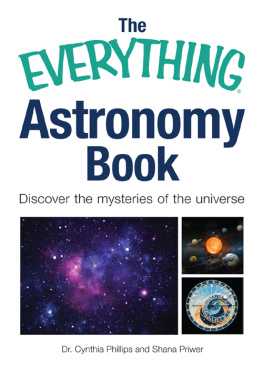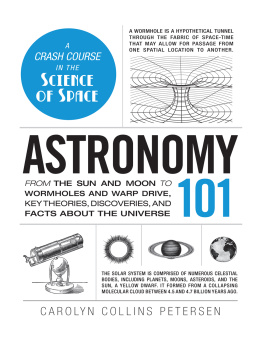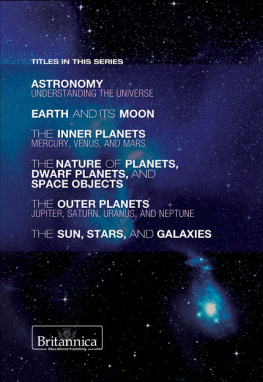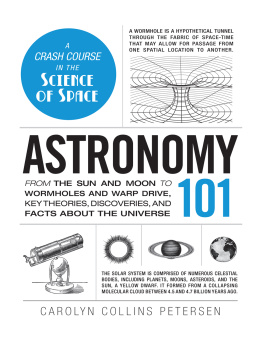Welcome to the EVERYTHING series!
These handy, accessible books give you all you need to tackle a difficult project, gain a new hobby, comprehend a fascinating topic, prepare for an exam, or even brush up on something you learned back in school but have since forgotten.

Important sound bytes of information
You can read an EVERYTHING book from cover-to-cover or just pick out the information you want from our four useful boxes: e-facts, e-ssentials, e-alerts, and e-questions. We literally give you everything you need to know on the subject, but throw in a lot of fun stuff along the way, too.

Quick handy tips

Urgent warnings
We now have well over 100 EVERYTHING books in print, spanning such wide-ranging topics as weddings, pregnancy, wine, learning guitar, one-pot cooking, managing people, and so much more. When youre done reading them all, you can finally say you know EVERYTHING!

Solutions to common problems
THE

Series!
Dear Reader,
Thanks for picking up The EverythingAstronomy Book! We hope you enjoy reading it as much as we enjoyed writing it.
Astronomy is a different sort of subject, one that can be enjoyed equally by regular people in their own backyards and by astrophysicists in mountaintop observatories. Although astronomy can sometimes seem daunting to a beginner, just about anyone can look up at the night sky and enjoy the stars. Even a little knowledge, such as learning the constellations, where to find the planet Jupiter, or when to look for a meteor shower, can increase your enjoyment immensely.
Keep reading to find out how you can discover a new comet or asteroid, or record observations of a meteor shower or variable star. And dont worry, there wont be any math required, and theres no exam at the end of the book.
Weve tried to make The EverythingAstronomy Book as accessible as possible for future astronomers of all levels. Just make sure that your mind is open to new experiences, including viewing stars and galaxies, seeing back in time, and learning about the origin of the universe and what our eventual destiny will be.
Clear skies!

THE

ASTRONOMY
BOOK
Discover the mysteries of the universe
Cynthia Phillips, Ph.D., and Shana Priwer

 To our children Zoecyn and Elijah
To our children Zoecyn and Elijah
Special thanks to Dr. Marshall Gilula for love and support, and to Raven for proofreading.
Contents
Introduction
Have you always wondered about the sky? Have you looked up at the multitude of stars and tried to find a constellation, but gotten lost when you tried to connect the dots? Do you know which bright objects in the sky are stars and which are planets? Have you wondered what a shooting star is? Have you ever worried that Earth might be hit by an asteroid?
Since ancient times, humans have looked up at the sky in wonder. Stars have always been a source of speculation, and detailed stories were invented by ancient cultures to explain the meanings of what we see in the cosmos. Fables concerning gods, mythological beasts, and other flights of fancy have all been inspired by the night sky. Stars were used to tell the seasons, determine when it was time to plant crops or hunt certain kinds of game, navigate from one place to another, and find the way back home. Dramatic cosmic events, such as an exploding supernova or a comet, would often be interpreted as a prophecy of a great historical moment or impending doom.

FIGURE 0-1:
A spiral galaxy from a distance
(refer to page 278 for more information)

FIGURE 0-2:
The Globular Cluster M15
(refer to page 278 for more information)
A good understanding of the nature of the stars did not come until the twentieth century. With the invention of sophisticated telescopes and ways of measuring the distances to celestial objects, astronomers realized that some objects in the sky were much farther away than others. An accurate understanding of the immense distances involved in astronomy was finally available.
Astronomers eventually came to understand that the stars in the sky are part of our own galaxy, as distinguished from nebulae, galaxies, and other objects that are far beyond the reaches of our own corner of the universe. The light from some stars in our galaxy takes many hundreds or thousands of years to reach us. Some of the other objects in the sky are, in fact, completely separate galaxies, which contain thousands or millions of stars of their own.
Astronomy is a unique science because although a true understanding requires years of study, anyone interested in looking up at the sky can enjoy its wonder. Amateur astronomy clubs exist all over the country and around the world. People can meet, help each other build or use telescopes and binoculars, and share in observing spectacular celestial objects.
Amateur astronomers, ones who do astronomy simply for the fun of it, can make significant contributions to the field. Amateurs routinely discover new comets, which can be named after them, and make important observations of celestial objects and events such as meteor showers. Astronomy is one of the few fields where amateurs are not only welcome, but also a necessary part of the larger community. The sky is an enormous place, and interested individuals from all over the world need to contribute their observations.
Some amateur astronomers have expensive and sophisticated equipment such as computer-controlled telescopes, deep-sky catalogs, and other observation and calculation devices. However, you can get involved in the excitement of astronomy simply by finding a dark place on a clear night and looking up.
Whether you already know the difference between Ursa Major and Ursa Minor, or you have trouble finding the Moon, this book is for you. You will learn how to find north without a compass, how to distinguish between different celestial bodies, and what would happen if you got pulled into a black hole. Common myths will be debunkedyou will learn why the Big Dipper is not an actual constellation, and that a shooting star isnt really a star at all.




















 To our children Zoecyn and Elijah
To our children Zoecyn and Elijah
